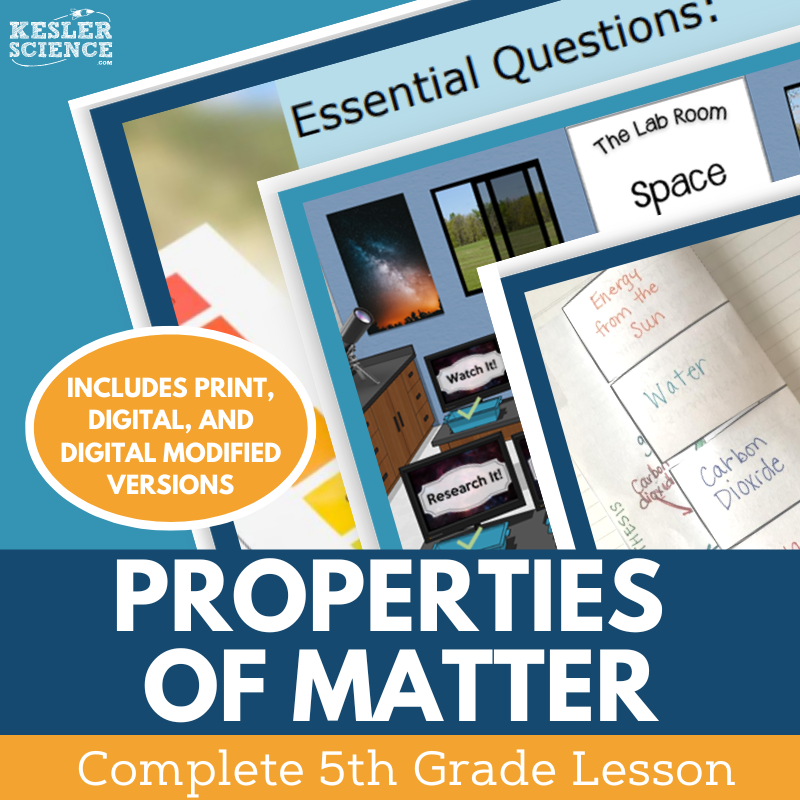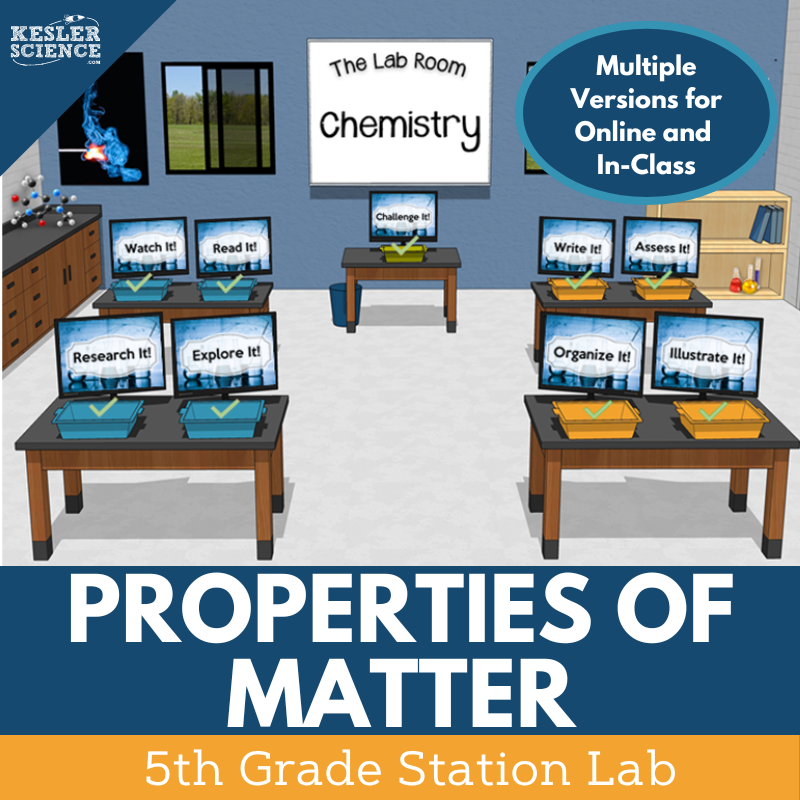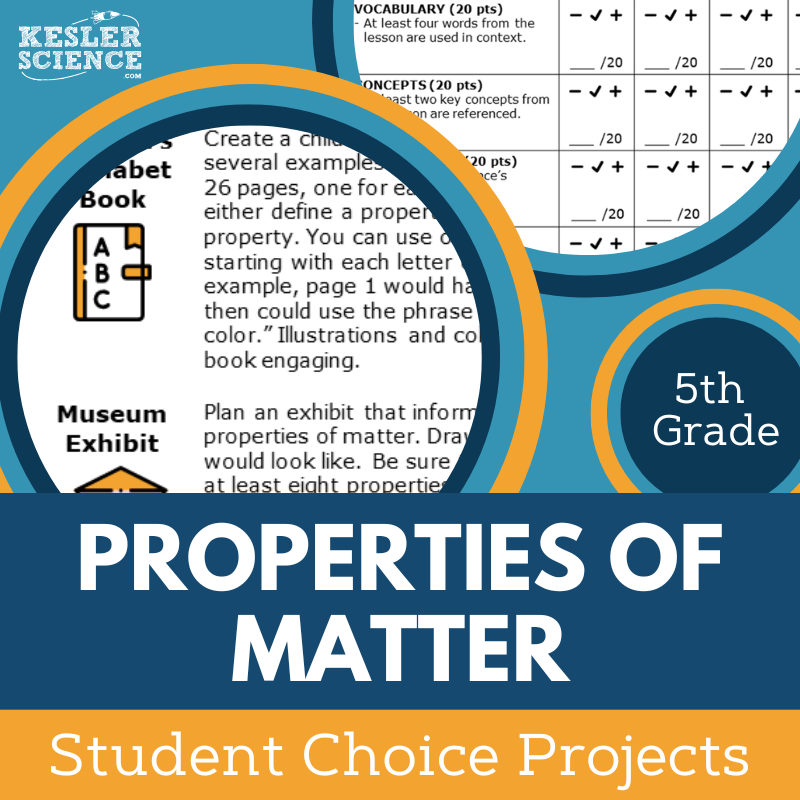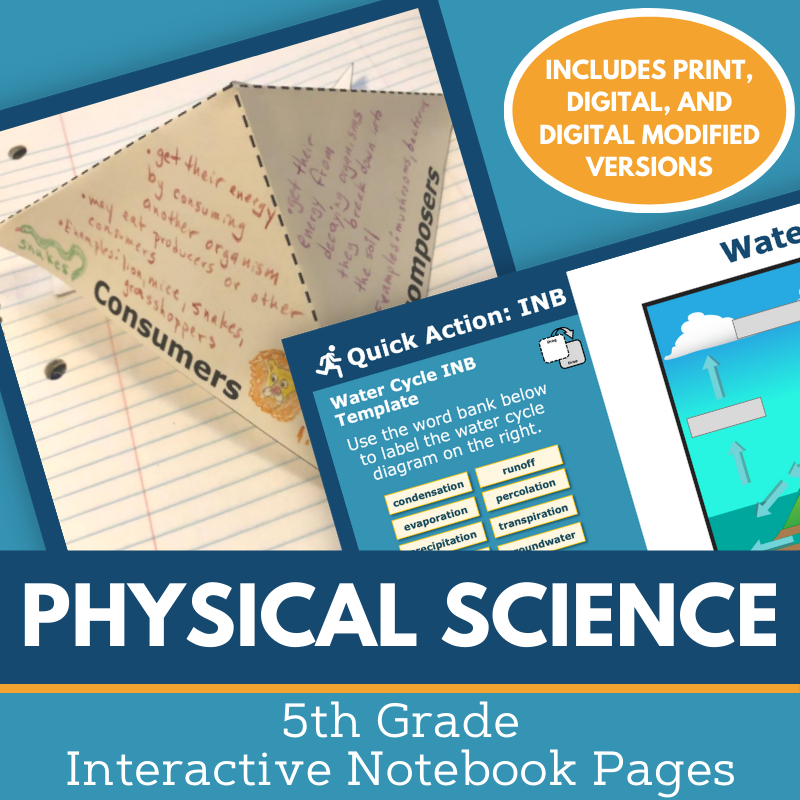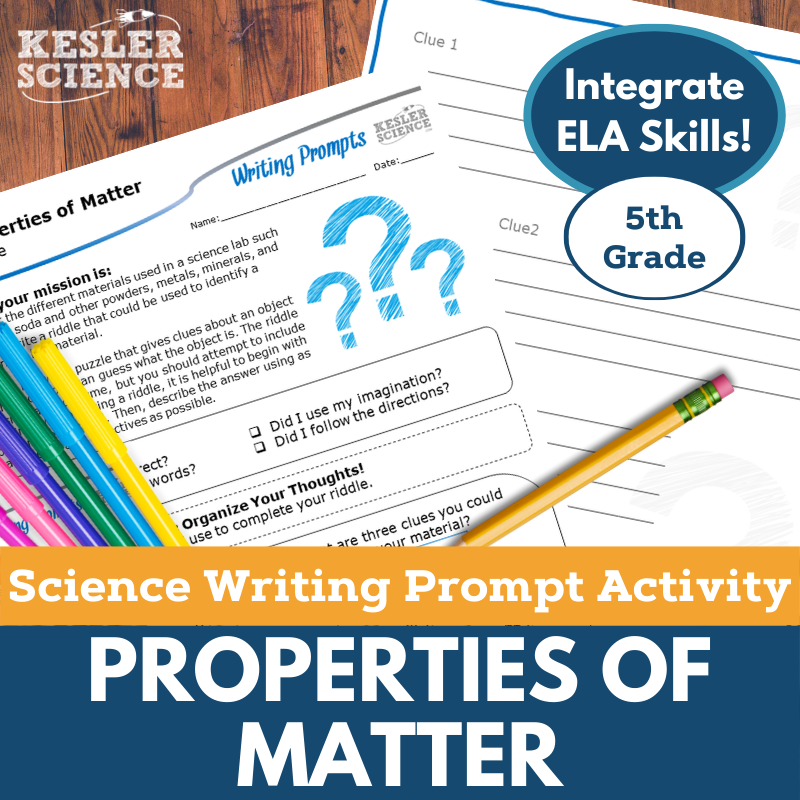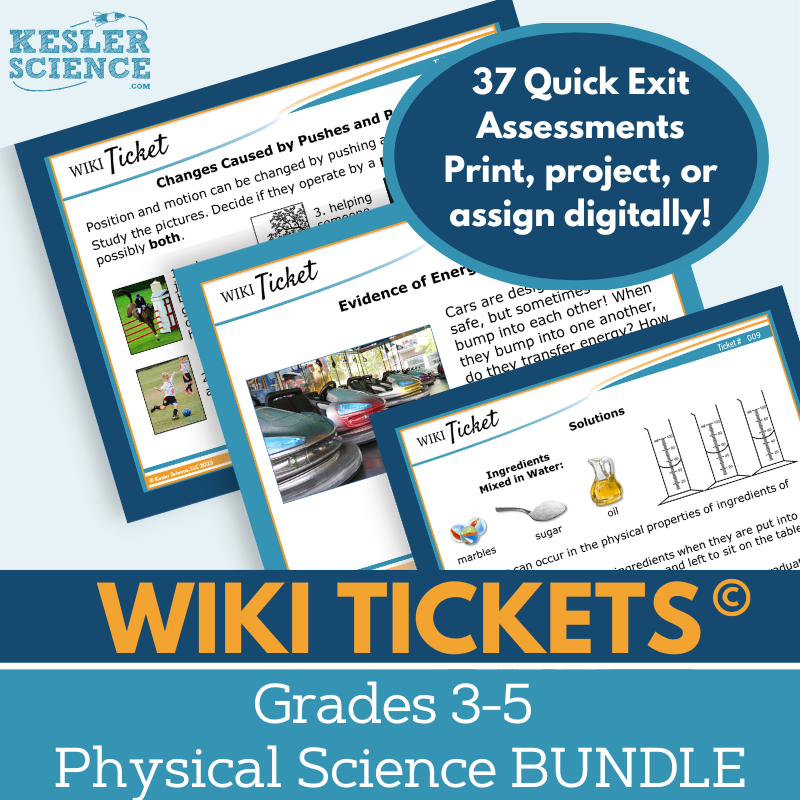Properties of Matter Activities for 5th Grade Science
The Kesler Science Properties of Matter resources offers a student-centered approach to learning about matter’s properties and states. The resources below will give students a comprehensive understanding of properties of matter. All of the following materials are also included in the Kesler Science Membership.
The Kesler Science Properties of Matter 5E Lesson offers a complete, engaging chemistry unit for elementary students focused on identifying substances through observable and testable properties. Designed to minimize prep and maximize student engagement, the unit includes editable presentations, worksheets, choice projects, and assessments. Lessons are fully aligned to NGSS 5-PS1-3 and the 2017 Texas TEKS, with flexible options for in-person or virtual instruction.
Following the 5E Model, the unit begins with engaging discussions and hands-on class activities. Students then explore the concept through a differentiated, student-led station lab that includes reading passages, videos, experiments, and online research. Output stations allow students to show their understanding by organizing, writing, illustrating, or completing assessment tasks, while a bonus challenge station supports early finishers.
For explanation and elaboration, the unit features editable PowerPoints, interactive notebook templates in English and Spanish, and student-choice projects to reinforce concepts. Evaluation resources include review worksheets and updated STAAR 2.0-aligned assessments. This multimodal, differentiated unit helps students master key physical science concepts while encouraging independent learning.
The Kesler Science Properties of Matter 5E Lesson offers a complete, engaging chemistry unit for elementary students focused on identifying substances through observable and testable properties. Designed to minimize prep and maximize student engagement, the unit includes editable presentations, worksheets, choice projects, and assessments. Lessons are fully aligned to NGSS 5-PS1-3 and the 2017 Texas TEKS, with flexible options for in-person or virtual instruction.
Following the 5E Model, the unit begins with engaging discussions and hands-on class activities. Students then explore the concept through a differentiated, student-led station lab that includes reading passages, videos, experiments, and online research. Output stations allow students to show their understanding by organizing, writing, illustrating, or completing assessment tasks, while a bonus challenge station supports early finishers.
For explanation and elaboration, the unit features editable PowerPoints, interactive notebook templates in English and Spanish, and student-choice projects to reinforce concepts. Evaluation resources include review worksheets and updated STAAR 2.0-aligned assessments. This multimodal, differentiated unit helps students master key physical science concepts while encouraging independent learning.
This modular, student-led activity about the properties of matter will keep your 5th-grade students engaged throughout this physical science lesson. In this station lab, students will make observations and take measurements to identify materials based on their physical properties. Designed to minimize prep time, the lab supports student-directed learning and is included in the full Properties of Matter lesson, which also features presentations, interactive notebook activities, assessments, and more.
The lab includes nine stations—eight differentiated activities and one challenge station for early finishers. These stations provide a range of learning experiences, from hands-on demonstrations and readings to video analysis and online research. Students interact with materials through both physical tasks and digital tools using PowerPoint or Google Slides, making it adaptable for in-class or virtual instruction.
Stations are divided into input and output categories. Input stations—Explore It!, Read It!, Research It!, and Watch It!—introduce students to the concept through multiple modes of engagement. Output stations—Organize It!, Illustrate It!, Write It!, and Assess It!—allow students to demonstrate understanding in varied ways, such as drawing, writing, manipulating data, and answering comprehension questions. A bonus Challenge It! station offers enrichment for students ready to go deeper.
This modular, student-led activity about the properties of matter will keep your 5th-grade students engaged throughout this physical science lesson. In this station lab, students will make observations and take measurements to identify materials based on their physical properties. Designed to minimize prep time, the lab supports student-directed learning and is included in the full Properties of Matter lesson, which also features presentations, interactive notebook activities, assessments, and more.
The lab includes nine stations—eight differentiated activities and one challenge station for early finishers. These stations provide a range of learning experiences, from hands-on demonstrations and readings to video analysis and online research. Students interact with materials through both physical tasks and digital tools using PowerPoint or Google Slides, making it adaptable for in-class or virtual instruction.
Stations are divided into input and output categories. Input stations—Explore It!, Read It!, Research It!, and Watch It!—introduce students to the concept through multiple modes of engagement. Output stations—Organize It!, Illustrate It!, Write It!, and Assess It!—allow students to demonstrate understanding in varied ways, such as drawing, writing, manipulating data, and answering comprehension questions. A bonus Challenge It! station offers enrichment for students ready to go deeper.
The Properties of Matter Student Choice Projects align with 5th grade science standards and allow students to demonstrate their understanding in a format that suits their learning style. A project page offers nine creative options—including a “design your own” project—and includes a rubric that can be used by teachers, peers, or the students themselves for assessment.
These projects are designed for flexibility and differentiation. Two versions of the project page are included: a standard version and a modified version that offers extra support for students needing remediation. Teachers can also assign a combination of projects to challenge advanced learners while still using the same grading rubric. All materials are editable to meet classroom needs.
Students can complete the projects using common classroom supplies such as paper, markers, and scissors. Many options are available for digital completion, and additional crafting materials can enhance model-building tasks. This student-led format provides a multimodal, engaging way for students to show their mastery of the properties of matter.
The Properties of Matter Student Choice Projects align with 5th grade science standards and allow students to demonstrate their understanding in a format that suits their learning style. A project page offers nine creative options—including a “design your own” project—and includes a rubric that can be used by teachers, peers, or the students themselves for assessment.
These projects are designed for flexibility and differentiation. Two versions of the project page are included: a standard version and a modified version that offers extra support for students needing remediation. Teachers can also assign a combination of projects to challenge advanced learners while still using the same grading rubric. All materials are editable to meet classroom needs.
Students can complete the projects using common classroom supplies such as paper, markers, and scissors. Many options are available for digital completion, and additional crafting materials can enhance model-building tasks. This student-led format provides a multimodal, engaging way for students to show their mastery of the properties of matter.
The Kesler Science Physical Science Interactive Notebook bundle engages elementary students in 13 essential physical science topics with both print and digital formats. This versatile resource supports traditional classrooms, 1:1 environments, and distance learning, ensuring all students can actively participate.
The digital version includes an interactive PowerPoint that can be uploaded to Google Slides and various LMS platforms, with reflection pages, note-taking spaces, teacher answer keys, and a modified version for accommodations. The paper version provides blank and pre-filled templates, along with color photos for guidance.
Topics range from properties of matter and energy use to gravitational force and circuits. Whether used for interactive learning, differentiation, or student reflection, this notebook bundle makes science more engaging and accessible.
The Kesler Science Physical Science Interactive Notebook bundle engages elementary students in 13 essential physical science topics with both print and digital formats. This versatile resource supports traditional classrooms, 1:1 environments, and distance learning, ensuring all students can actively participate.
The digital version includes an interactive PowerPoint that can be uploaded to Google Slides and various LMS platforms, with reflection pages, note-taking spaces, teacher answer keys, and a modified version for accommodations. The paper version provides blank and pre-filled templates, along with color photos for guidance.
Topics range from properties of matter and energy use to gravitational force and circuits. Whether used for interactive learning, differentiation, or student reflection, this notebook bundle makes science more engaging and accessible.
The Properties of Matter Science Writing Activity engages 5th grade students in a creative riddle-based writing prompt to reinforce their understanding of physical science. Aligned with NGSS 5-PS1-3, this fun, print-or-digital resource allows students to observe and describe materials based on their physical properties while building their science reasoning and writing skills. The activity supports virtual and in-person instruction, making it ideal for a range of classroom environments.
This low-prep, student-centered writing task includes everything needed for classroom success: teacher directions with rubrics and project ideas, full-sized and half-sheet handouts, and a projection version to reduce paper use. A digital PowerPoint version is also included and can easily be used with Google Slides, allowing flexible completion in either platform’s Edit mode. The layout templates and pre-writing tools help students organize their ideas, and the final riddles make a great addition to writing journals or classroom displays.
This versatile writing prompt can serve as a cross-curricular project, early finisher activity, or pre-test assessment. It’s also great for differentiation, extra credit, make-up work, and TELPAS writing samples. Designed as a review activity, it assumes students have prior knowledge or access to research materials to support their responses.
The Properties of Matter Science Writing Activity engages 5th grade students in a creative riddle-based writing prompt to reinforce their understanding of physical science. Aligned with NGSS 5-PS1-3, this fun, print-or-digital resource allows students to observe and describe materials based on their physical properties while building their science reasoning and writing skills. The activity supports virtual and in-person instruction, making it ideal for a range of classroom environments.
This low-prep, student-centered writing task includes everything needed for classroom success: teacher directions with rubrics and project ideas, full-sized and half-sheet handouts, and a projection version to reduce paper use. A digital PowerPoint version is also included and can easily be used with Google Slides, allowing flexible completion in either platform’s Edit mode. The layout templates and pre-writing tools help students organize their ideas, and the final riddles make a great addition to writing journals or classroom displays.
This versatile writing prompt can serve as a cross-curricular project, early finisher activity, or pre-test assessment. It’s also great for differentiation, extra credit, make-up work, and TELPAS writing samples. Designed as a review activity, it assumes students have prior knowledge or access to research materials to support their responses.
The Kesler Science Physical Science WIKI Tickets provide 3rd–5th grade teachers with engaging, low-prep formative assessments. These colorful exit tickets help quickly gauge student understanding in chemistry, energy, and force and motion topics, aligning with NGSS and TEKS standards. Each of the 37 topics includes five formats: a full-screen display, three printable handout sizes, and a digital interactive version in PowerPoint or Google Slides.
WIKI Tickets are versatile for any learning environment. Teachers can project them for class discussions, print them for written responses, or assign them digitally for remote learning. The included table of contents file ensures seamless alignment with science standards, making assessments easy and effective.
With WIKI standing for “What I Know Is,” these tickets work as bellringers, exit slips, or quick checks for understanding. Whether in class or online, this resource offers a simple yet powerful way to track student progress in physical science concepts.
The Kesler Science Physical Science WIKI Tickets provide 3rd–5th grade teachers with engaging, low-prep formative assessments. These colorful exit tickets help quickly gauge student understanding in chemistry, energy, and force and motion topics, aligning with NGSS and TEKS standards. Each of the 37 topics includes five formats: a full-screen display, three printable handout sizes, and a digital interactive version in PowerPoint or Google Slides.
WIKI Tickets are versatile for any learning environment. Teachers can project them for class discussions, print them for written responses, or assign them digitally for remote learning. The included table of contents file ensures seamless alignment with science standards, making assessments easy and effective.
With WIKI standing for “What I Know Is,” these tickets work as bellringers, exit slips, or quick checks for understanding. Whether in class or online, this resource offers a simple yet powerful way to track student progress in physical science concepts.
Year-Round Resources
These year-round activities will increase your students' understanding of many middle school science topics. All of these activities are also included in the Kesler Science Membership.
Visual Data & Graphing
You're not alone if your students struggle with understanding graphs, charts, and tables. It's a skill that takes an enormous amount of practice. This resource will help students build a strong foundation in analyzing data and creating their own data visualizations.
Bell Ringers and Warm-Ups
These middle school science bell ringers are an excellent way to engage your students as soon as they walk into your classroom. This comprehensive FULL YEAR resource includes everything you need to start off each science class with an interesting warm-up activity.
Review Board Games
Each game board has been carefully designed to keep students engaged. There are 10 different action spaces on each board and dozens of question cards. All of the actions are related to science concepts and keep the students motivated throughout the game.
Each game is ready to play. Simply print out the board and the cards and let the students enjoy reviewing nine different units.
Essential Questions
Below are the essential questions associated with the lessons and activities included in this unit. This topic is only one of more than 100 middle school science topics included in the Kesler Science Membership.
-
What can we tell about an unknown substance by its properties?
-
What tests can we perform to identify an unknown substance?
Kesler Science Membership
Imagine never having to search for another middle school science lesson again. The membership gives you access to ALL of the Kesler Science products in one place (Yes, including everything above).
Say goodbye to long hours of lesson prep.

